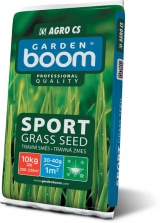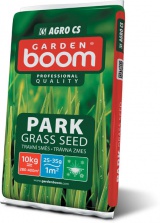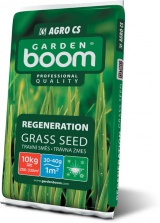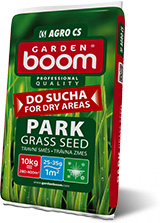GRASS-SEED MIXTURES
Garden Boom offers 3 basic grass mixtures meeting high requirements particularly in these fields:
DensityResistance to heavy use and diseases
Fast regeneration
Appearance-quality of your lawn

Grass-Seed Mixture SPORT
t’s designated for lawns with intensive load. Its composition combines mainly the species of meadow-grasses and ryegrass to have a high-quality and resistant lawn with really good regeneration. The lawn composition comes from long-time experience in lawn-sowing and care for professional sport-grasses.
| Species | % | |
| Bunch-type red fescue | Festuca rubra commutata | 15 |
| Tall up-growing red fescue | Festuca rubra rubra | 10 |
| Smooth meadow-grass | Poa Pratensis | 10 |
| Perennial rye-grass | Lolium Perenne | 65 |
Resistance to load: high
Growing speed: high
Care-taking requirements: medium
Grass-mowing height: 3 – 5 cm
Sowing quantity: 30 – 40 g/m²
Packaging: 10 kg

Grass-Seed Mixture PARK
It’s mainly designated for decorative lawns for parks or family gardens with a lower load-intensity, primarily emphasising the lawn appearance. The basis of the mixture combines red fescues supporting the dense grass bundle with lower growth.
| Species | % | |
| Bundle-type red fescue | Festuca rubra commutata | 20 |
| Short-outgrowing red fescue | Festuca rubra trichophylla | 20 |
| Tall up-growing red fescue | Festuca rubra rubra | 20 |
| Smooth meadow-grass | Poa pratensis | 10 |
| Perennial rye-grass | Lolium perenne | 30 |
Resistance to load: medium
Growth-engaging speed: medium
Care-taking requirements: medium
Grass-mowing height: 2 – 5 cm
Sowing quantity: 25 – 30 g/m²
Packaging: 10 kg

Grass-Seed Mixture REGENERATION
It’s designated for regenerating of damaged lawns. The main benefit of the mixture is its really high growth and root-integration in the existing lawn. The basis of the mixture consists of perennial ryegrass meeting the principal requirement for fast-integrating seed-root system into the existing lawn to regenerate its damaged spots.
| Species | % | |
| Bundle-type red fescue | Festuca rubra commutata | 20 |
| Perennial rye-grass | Lolium perenne | 80 |
Resistance to load: high
Growth-engaging speed: high
Care-taking requirements: medium
Mowing height: 3 – 6 cm
Sowing quantity: 30 – 40 g/m²
Packaging: 10 kg

Grass-Seed Mixture PARK for dry areas
It’s mainly designated for decorative lawns for parks or family gardens with a lower load-intensity, primarily emphasising the lawn appearance. The basis of the mixture combines red fescues supporting the dense grass bundle with lower growth.
| Species | % | |
| Tall fescue | Festuca arundinacea | 70 |
| Smooth meadow-grass | Poa pratensis | 20 |
| Perennial rye-grass | Lolium perenne | 10 |
Resistance to load: medium
Growth-engaging speed: medium
Care-taking requirements: medium – low
Mowing height: 3 – 5 cm
Sowing quantity: 30 – 40 g/m²
Packaging: 10 kg
GARDEN BOOM Grass Mixtures Providing a Special System of Top Grass-Seed Species
They conform to RSM evaluation systems (applied in Germany) and STRI evaluation systems (applied in England).
They comply with the highest quality requirements under the Garden Boom trademark.
They combine individual species and varieties of perennial rye grass, smooth stalked meadow grass and red fescue grasses to bring forth a complex range of top grass-seed mixtures.
They comply with the highest quality requirements under the Garden Boom trademark.
They combine individual species and varieties of perennial rye grass, smooth stalked meadow grass and red fescue grasses to bring forth a complex range of top grass-seed mixtures.
Basic Grass-Seed Species and their Properties
Perennial rye-grass – Lolium perenne
Excellent resistance to heavy useFast germination after seeding
Lower resistance to dryness
Higher maintenance requirements
When complying with recommended maintenance instructions, perennial rye-grass together with other grass-seed species make a nice high-quality turf.

Smooth stalked meadow-grass – Poa pratensis
Resistance to oversteppingTolerance to coldness
Excellent appearance after mowing
Slow germination (3 – 4 weeks)
Smooth stalked meadow-grass combined with perennial rye-grass is suitable for turfs for heavily used areas.

Red fescues – Festuca rubra
Leaf-finenessDensity
Tolerance to shadowing
Regeneration speed
Resistance to heavy use (to be better used in decoration lawns)
Red-fescues themselves are further divided into bunch-type fescues, short-outgrowing and tall-up growing fescues. Combining these three subspecies will provide a high-quality lawn.

Properties of the grass-seed species: 1- the worst; 10 – the best
| Properties of the grass-seed varieties | Perennial rye-grass | Tall-outgrowing fescue | Bunch-type fescue | Short-outgrowing fescue | Smooth meadow-grass |
| Tolerance to load | 10 | 4 | 3 | 4 | 9 |
| Resistance to diseases | 6 | 7 | 5 | 4 | 7 |
| Tolerance to dryness | 4 | 6 | 7 | 8 | 5 |
| Growing-up speed | 10 | 8 | 7 | 6 | 2 |
| Nutrients needed | 9 | 6 | 4 | 4 | 8 |
| Tolerance to high temperatures | 2 | 5 | 6 | 6 | 5 |
| Leaf fineness | 4 | 4 | 8 | 8 | 3 |
| Cleanness after mowing | 4 | 7 | 8 | 8 | 3 |
| Tolerance to the salting | 4 | 5 | 7 | 8 | 4 |
| Tolerance to the shadowing | 5 | 5 | 6 | 6 | 5 |
| Density | 5 | 4 | 9 | 9 | 5 |
| Tolerance to wetness | 2 | 4 | 4 | 4 | 4 |
| Producing felt | 1 | 4 | 5 | 6 | 7 |
| Tolerance to coldness | 2 | 3 | 3 | 3 | 6 |
Main Rules for Selecting Grass-Seed Mixtures
Character of the grass-seed mixture – decorative, load-bearing
Root-system growing speed
Treatment needed
Grass-mowing height
Grass-sowing quantity per m²
Grass-sowing period
Irrigation needed – natural precipitation, automatic irrigation system
Subsequent care – mowing, fertilization
Root-system growing speed
Treatment needed
Grass-mowing height
Grass-sowing quantity per m²
Grass-sowing period
Irrigation needed – natural precipitation, automatic irrigation system
Subsequent care – mowing, fertilization

 English
English Česky
Česky Slovenčina
Slovenčina Polski
Polski Deutsch
Deutsch Français
Français Român
Român Magyar
Magyar